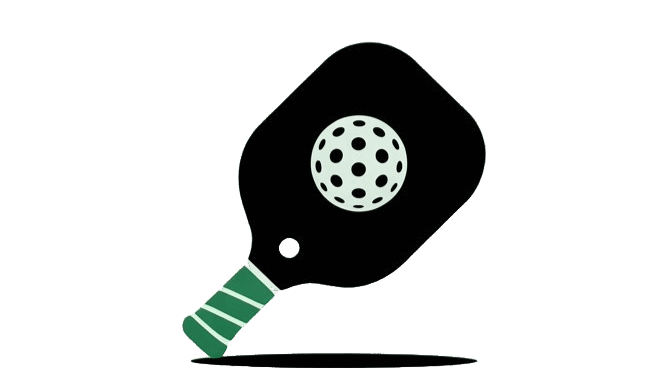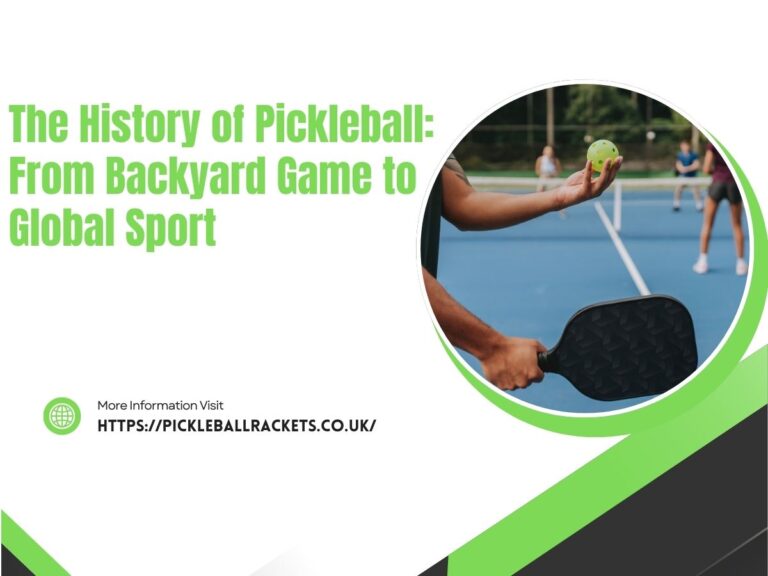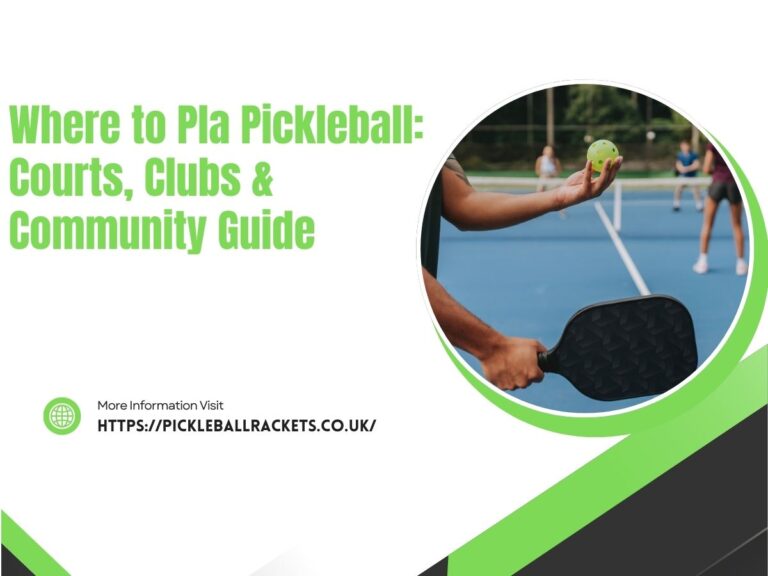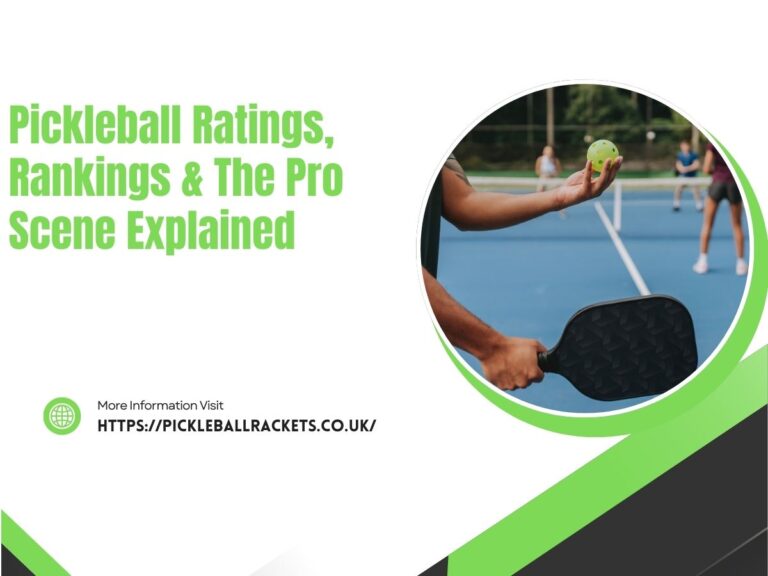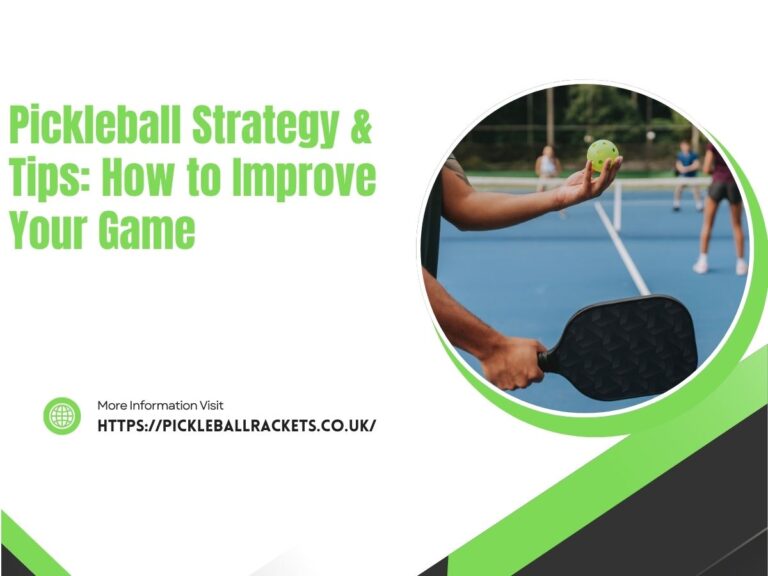Pickleball is more than just a quirky name for a sport; it’s a fitness phenomenon sweeping across the UK and the globe. Combining elements of tennis, badminton, and table tennis, this accessible and social game offers a surprising array of health benefits. Whether you’re a seasoned athlete or someone looking for a fun new way to get active, pickleball provides a comprehensive workout for both body and mind.
This guide will explore everything you need to know about the fitness side of pickleball. We will cover its benefits as an exercise, how many calories you can burn, its suitability for seniors and those with health concerns, and crucial safety tips to keep you on the court. We’ll also compare it to other racket sports and provide routines to help you prepare and recover.
Is Pickleball Good Exercise?
Absolutely. Don’t let the smaller court and slower ball fool you; pickleball is a fantastic form of exercise that delivers a full-body workout. It challenges you in several ways, making it a well-rounded physical activity. The dynamic nature of the game ensures you’re constantly moving, engaging various muscle groups and boosting your heart rate. Let’s break down the specific pickleball exercise benefits.
A Powerful Cardiovascular Workout
One of the most significant health benefits of pickleball is its effect on your cardiovascular system. Is pickleball good cardio? The answer is a resounding yes. A typical game involves constant movement: forward and backward dashes to the non-volley zone (or “kitchen”), lateral shuffles along the baseline, and quick pivots to return shots. This sustained activity elevates your heart rate into the moderate-intensity zone, which is ideal for improving heart health.
Regularly engaging in cardiovascular exercise like pickleball can lead to:
- A stronger heart muscle: Your heart becomes more efficient at pumping blood throughout your body.
- Lower blood pressure: Physical activity helps relax blood vessel walls, reducing resistance.
- Improved circulation: Better blood flow delivers more oxygen and nutrients to your tissues.
- Reduced risk of heart disease: Consistent cardio is a cornerstone of preventing cardiovascular issues.
Even in a doubles match, which is less physically demanding than singles, you’ll find yourself in a state of continuous, low-to-moderate exertion. This makes it an excellent and sustainable form of aerobic exercise for people of all fitness levels.
Building Strength, Agility, and Power
While not a replacement for dedicated weightlifting, pickleball helps build and maintain functional strength throughout your body. The quick, explosive movements required during a game are a form of plyometric exercise.
- Lower Body: Lunging for a low dink, squatting to get under the ball, and pushing off for a quick sprint all engage your glutes, quadriceps, hamstrings, and calves. These movements build lower-body strength and power.
- Core: Your core muscles—abdominals, obliques, and lower back—are constantly at work. Every swing, twist, and change of direction requires core stability to transfer power and maintain balance. A strong core is also vital for preventing pickleball back pain.
- Upper Body: Your shoulders, arms, and back get a workout from swinging the paddle. While the paddle is light, the repetitive motion of hitting forehands, backhands, and overhead smashes builds endurance and tones the muscles in your arms and upper back.
Enhancing Balance, Coordination, and Reflexes
Pickleball is a game of quick reactions. You need to track a small, perforated plastic ball, anticipate its trajectory after it bounces, and position your body to execute a precise shot—often in a fraction of a second. This demands a high level of hand-eye coordination.
Furthermore, the sport significantly improves balance. The need to move laterally, change direction suddenly, and maintain stability while lunging for a shot constantly challenges your body’s proprioceptive system. This is the sense that tells you where your body parts are in space. Improved balance is crucial for preventing falls, a benefit that makes pickleball particularly valuable for older adults.
Mental Stimulation and Social Engagement
The fitness benefits of pickleball aren’t purely physical. The game is a workout for your brain, too. You must constantly think about strategy: where to place your shot, how to exploit your opponent’s weakness, and when to be aggressive versus when to play defensively. This strategic thinking keeps your mind sharp.
Beyond the mental gymnastics, pickleball is inherently social. Typically played in a doubles format, it fosters communication, teamwork, and camaraderie. The courts are often filled with laughter and encouragement, making it a positive and motivating environment. This social connection is a powerful antidote to stress and a key component of overall well-being, highlighting the mental health benefits of pickleball.
How Many Calories Does Pickleball Burn?
One of the most common questions from fitness-focused players is about the calorie-burning potential of the sport. The number of calories burned playing pickleball can vary widely based on several factors, but it’s a more effective calorie-burner than many people assume.
A general estimate suggests that a person weighing around 160 pounds (approximately 72.5 kg) can burn between 250 and 400 calories per hour playing doubles at a social, moderate pace. For more competitive, intense play, that number can climb to 400-700 calories per hour.
Let’s look at the key factors influencing your calorie burn.
Factors Affecting Calorie Expenditure
Intensity of Play: This is the most significant factor. A casual game with long breaks between points will burn far fewer calories than a competitive match with long, fast-paced rallies. Aggressive players who run for every shot will have a much higher energy expenditure.
Singles vs. Doubles: Singles pickleball is a far more demanding workout. You are responsible for covering the entire court, which means more sprinting, more lateral movement, and less rest between shots. A singles player can easily burn 30-50% more calories than a doubles player in the same amount of time.
Body Weight: A heavier individual will burn more calories than a lighter person performing the same activity for the same duration. This is because it takes more energy to move a larger body mass.
Age and Fitness Level: Younger, fitter players may be able to sustain a higher intensity for longer, leading to a greater total calorie burn. However, metabolic rates can vary, and an older but very active player might out-burn a less-fit younger player.
Playing Style: Do you play a soft “dinking” game at the net or a power game from the baseline? A baseline game involves more running and more powerful swings, which increases the calorie burn.
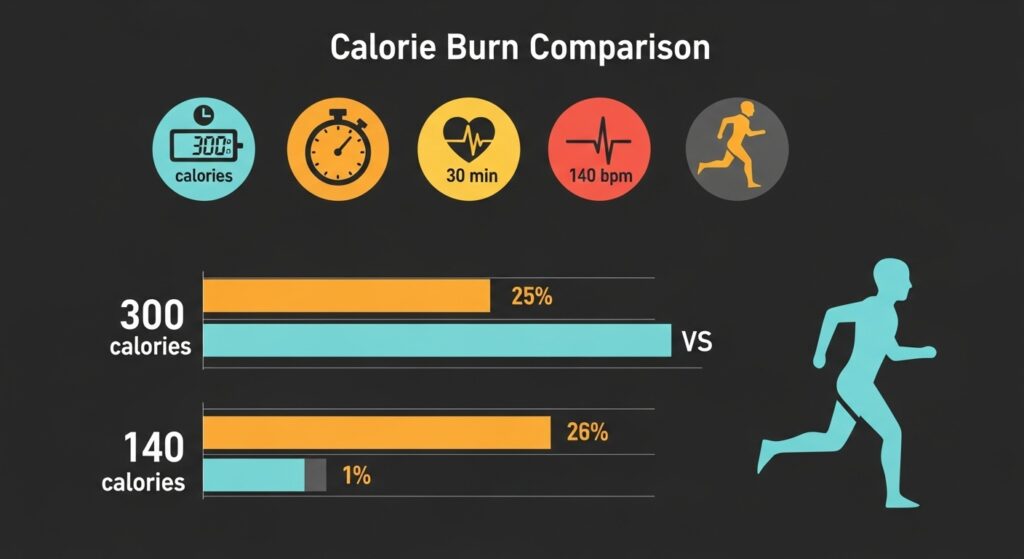
Pickleball Calorie Burn vs. Other Activities (Approximate)
To put it into perspective, here’s how the calories burned playing pickleball compare to other popular forms of exercise for a 160-pound person per hour:
- Social Pickleball (Doubles): 250-400 calories
- Competitive Pickleball (Singles): 450-700+ calories
- Walking (3.5 mph): ~280 calories
- Brisk Walking (4.5 mph): ~380 calories
- Recreational Tennis (Doubles): ~350 calories
- Competitive Tennis (Singles): ~580 calories
- Badminton (Social): ~290 calories
- Jogging (5 mph): ~580 calories
As you can see, competitive pickleball holds its own against more traditionally recognized cardio workouts like jogging and singles tennis. Even social pickleball provides a better workout than a moderate walk, making it an excellent choice for those looking to increase their daily activity levels in an enjoyable way.
Can You Lose Weight Playing Pickleball?
Yes, pickleball can be an effective tool for weight loss when combined with a healthy diet. The fundamental principle of weight loss is creating a consistent calorie deficit, which means burning more calories than you consume. Pickleball helps you achieve the “calories out” part of this equation in a fun and sustainable way.
Many people struggle to stick with exercise routines they find boring or monotonous. Pickleball’s engaging nature means you’re more likely to play regularly and for longer durations. You might find yourself playing for two hours without even realizing it, burning hundreds of calories in the process. This consistency is the key to long-term weight management.
For pickleball and weight loss to be successful, consider the following:
- Frequency: Aim to play at least 3-4 times per week to create a significant calorie deficit from exercise alone.
- Intensity: Push yourself during games. Volunteer to play against more challenging opponents or focus on playing singles occasionally to maximize your workout.
- Duration: Longer sessions burn more calories. If you can only play for an hour, try to make it a high-intensity session. If you have more time, a longer, moderate-paced game is also effective.
- Diet: Exercise alone is often not enough for significant weight loss. Pairing your pickleball routine with a balanced, nutrient-dense diet is crucial. You cannot out-play a bad diet.
By incorporating regular pickleball sessions into your lifestyle, you not only burn calories but also build muscle. Increased muscle mass boosts your resting metabolic rate, meaning you burn more calories even when you’re not playing. This combination makes pickleball an excellent component of a holistic weight loss strategy.
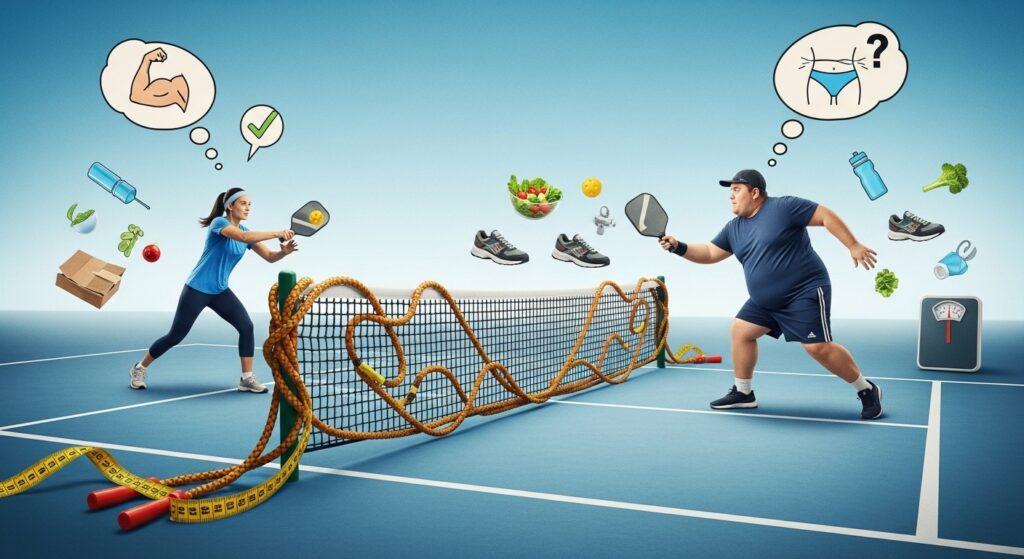
Pickleball for Seniors: A Safe and Social Fitness Solution
Pickleball has seen an explosion in popularity among older adults, and for good reason. It offers the perfect blend of physical activity, social interaction, and low-impact movement, making it an ideal sport for maintaining health and mobility later in life. So, is pickleball safe for older adults? With the right precautions, it is one of the best activities a senior can pick up.
Why It’s a Hit with the Senior Community
- Low-Impact on Joints: The smaller court size means less ground to cover compared to tennis. This translates to less running and less repetitive stress on the knees, hips, and ankles. The underhand serve and the slower speed of the ball also contribute to a more joint-friendly experience. This makes pickleball for arthritis sufferers a particularly good option.
- Improves Balance and Coordination: As discussed earlier, the need to react quickly and move in different directions is excellent training for balance. This is a critical benefit for seniors, as improved balance can drastically reduce the risk of falls, a leading cause of injury in older populations.
- Maintains Mobility and Flexibility: The game encourages players to reach, bend, and twist, which helps maintain a healthy range of motion in the joints. Regular play can combat the stiffness that often comes with age.
- Boosts Social Connection and Mental Wellness: For many retirees, pickleball provides a built-in community. It’s a chance to meet new people, engage in friendly competition, and combat feelings of loneliness or isolation. The social aspect is just as important as the physical for overall well-being.
- Scalable Intensity: Players can easily adjust the intensity of the game to match their fitness level and energy on any given day. A relaxed, social game is just as valid as a fast-paced, competitive one. This flexibility allows seniors to participate consistently without overexerting themselves.
The pickleball fitness UK scene, in particular, has seen a surge in senior players who appreciate the sport’s gentle learning curve and welcoming community atmosphere. It provides a way to stay active, healthy, and socially engaged throughout retirement.
Pickleball and Common Health Concerns
While pickleball is a relatively safe sport, its dynamic movements can pose challenges for individuals with pre-existing health conditions. However, with proper management, modifications, and medical advice, many people can still enjoy the game.
Pickleball and Your Knees & Back
Knee and back pain are two of the most common complaints among pickleball players of all ages. The quick stops, starts, and pivots can put significant strain on these areas.
Is Pickleball Bad for Knees?
It doesn’t have to be. The issue often isn’t the sport itself but rather improper form, inadequate conditioning, or poor footwear. Here’s how to protect your knees:
- Bend Your Knees: Many players bend at the waist to hit low shots, which strains the back and puts the knees in a vulnerable position. Instead, get into an athletic stance and “get low” by bending your knees in a squat or lunge.
- Avoid Abrupt Pivots: Instead of planting your foot and twisting your knee, take small, quick steps to turn your body towards the ball.
- Wear Proper Shoes: Court shoes designed for tennis or pickleball offer lateral support to prevent your foot from rolling during side-to-side movements. Running shoes are not recommended as they lack this stability.
- Strengthen Supporting Muscles: Exercises that strengthen the quadriceps, hamstrings, and glutes will provide better support for your knee joints.
Preventing Pickleball Back Pain
Similar to knee issues, pickleball back pain often stems from poor mechanics.
- Engage Your Core: A strong core acts as a natural corset, stabilizing your spine during rotational movements like swinging the paddle.
- Lift with Your Legs: When picking up a ball or hitting a low shot, squat down rather than hunching over from your waist.
- Warm-Up Properly: A thorough warm-up increases blood flow to your muscles, making them more pliable and less prone to strain. Focus on dynamic stretches that mimic game movements.
Pickleball with Arthritis
For many people with arthritis, the thought of exercise can be intimidating. However, gentle, regular activity is one of the best ways to manage symptoms. Because it is a low-impact sport, pickleball for arthritis can be highly beneficial. The movement helps lubricate the joints and can reduce pain and stiffness.
Precautions for Players with Arthritis:
- Listen to Your Body: Don’t play through sharp pain. It’s important to distinguish between the normal discomfort of stiff joints and pain that signals potential damage.
- Manage Flare-Ups: During a flare-up, it may be best to rest or engage in even gentler activities like walking or swimming.
- Consider Braces: A knee or elbow brace can provide extra support and stability to arthritic joints.
- Focus on Doubles: Playing doubles is less physically demanding and puts less stress on the body than singles.
Playing Pickleball While Pregnant
Is it safe to play pickleball during pregnancy? The answer depends on the individual, the stage of pregnancy, and the advice of a healthcare provider. For women who were active before pregnancy and are having a low-risk pregnancy, continuing to play pickleball, with modifications, is often possible, especially in the first and second trimesters.
Key Considerations and Modifications:
- Consult Your Doctor: This is the most important step. Get personalized advice based on your health history.
- Balance Changes: As pregnancy progresses, your center of gravity shifts, which can affect your balance and increase the risk of falls. Avoid aggressive lunges or sudden pivots.
- Avoid Overheating: Pregnant women are more susceptible to overheating. Play during cooler parts of the day, take frequent breaks, and stay exceptionally well-hydrated.
- Listen to Your Body: Pay close attention to signs of fatigue, dizziness, or discomfort. As your body changes, you will need to adjust your intensity and duration. Playing a very casual game of doubles is the safest approach.
For most, playing pickleball while pregnant means scaling back the intensity significantly and prioritizing safety above all else.
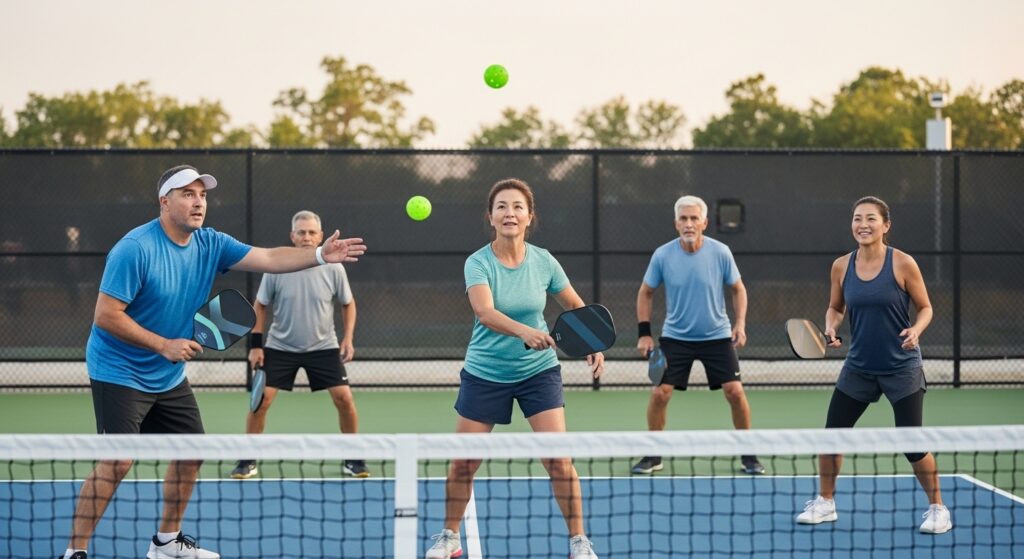
Comparing Pickleball’s Exercise Benefits
How does pickleball stack up against other popular racket sports like tennis, padel, and badminton? Each sport offers a unique set of fitness benefits.
- Pickleball vs. Tennis: Tennis generally provides a more intense cardiovascular workout due to the larger court size, requiring more sprinting and powerful groundstrokes. However, this also means it’s higher impact and places more stress on the joints. The pickleball vs tennis calories comparison shows tennis often burns more, but pickleball is more accessible, easier to learn, and gentler on the body, making it a more sustainable option for many.
- Pickleball vs. Padel: Padel is very similar to pickleball in its social, doubles-focused nature. The padel court is slightly larger, and the use of glass walls adds a different strategic element. The workout intensity is comparable, with both sports emphasizing quick reflexes and volleying skills over raw power and endurance running.
- Pickleball vs. Badminton: Badminton is an extremely fast-paced game that requires incredible agility, wrist strength, and overhead power. It can be a very intense cardio workout. However, it’s played indoors and lacks the outdoor, social “club” feel that attracts many to pickleball. Pickleball’s movements are less reliant on overhead smashing, making it easier on the shoulder for many players.
Ultimately, the “best” sport is the one you enjoy most and will play consistently. Pickleball’s unique advantage lies in its accessibility, low-impact nature, and strong community focus, making fitness feel less like a chore and more like play.
Safety Tips for Injury-Free Pickleball
To reap the health benefits of pickleball long-term, staying injury-free is paramount. Most pickleball injuries are preventable and result from overuse, improper preparation, or accidents. Following these safety tips will help keep you on the court.
1. The Importance of Warming Up and Cooling Down
Never step onto the court “cold.” A proper warm-up is essential for preparing your body for physical exertion.
- Dynamic Warm-Up (5-10 minutes): Start with light cardio like jogging in place or jumping jacks to raise your heart rate. Then, move into dynamic stretches that mimic game movements. This includes leg swings (forward and sideways), torso twists, arm circles, and walking lunges.
- Cool-Down and Static Stretching: After you finish playing, don’t just pack up and leave. Spend 5-10 minutes cooling down. A slow walk around the court helps your heart rate return to normal gradually. Follow this with static stretches, holding each stretch for 20-30 seconds. Focus on your hamstrings, quadriceps, calves, glutes, shoulders, and back.
2. Choosing the Right Gear, Especially Shoes
Your equipment plays a huge role in your safety.
- Footwear is Non-Negotiable: As mentioned, court shoes are a must. They are designed with reinforced sidewalls to support lateral movements and have durable, non-marking soles suitable for court surfaces. Running shoes have built-up heels and are designed for forward motion only, making you susceptible to ankle sprains during side-to-side shuffles.
- Eye Protection: A stray ball or paddle can cause serious eye injuries. While not always mandated, wearing protective eyewear is a smart precaution, especially in competitive play.
- Appropriate Paddle: Choose a paddle with a grip size that is comfortable for your hand to avoid “tennis elbow” or other wrist and forearm strains.
3. Hydration and Nutrition
Proper fueling and hydration are key to performance and injury prevention.
- Hydrate Before, During, and After: Drink water before you feel thirsty. For long sessions, especially in the heat, a sports drink can help replenish electrolytes lost through sweat. Dehydration can lead to muscle cramps, fatigue, and heat exhaustion.
- Fuel Your Body: Don’t play on an empty stomach. Have a light snack containing carbohydrates for energy about an hour before you play.
4. Know Your Limits and Avoid Overuse
Enthusiasm for pickleball can sometimes lead to playing too much, too soon.
- Listen to Your Body: Pain is your body’s signal to stop. Pushing through pain can turn a minor strain into a chronic injury.
- Gradually Increase Playtime: If you are new to the sport or returning after a break, start with shorter sessions (e.g., one hour) and gradually increase the duration and frequency of your play.
- Rest and Recover: Your muscles repair and get stronger during rest days. Ensure you schedule days off to allow your body to recover fully.
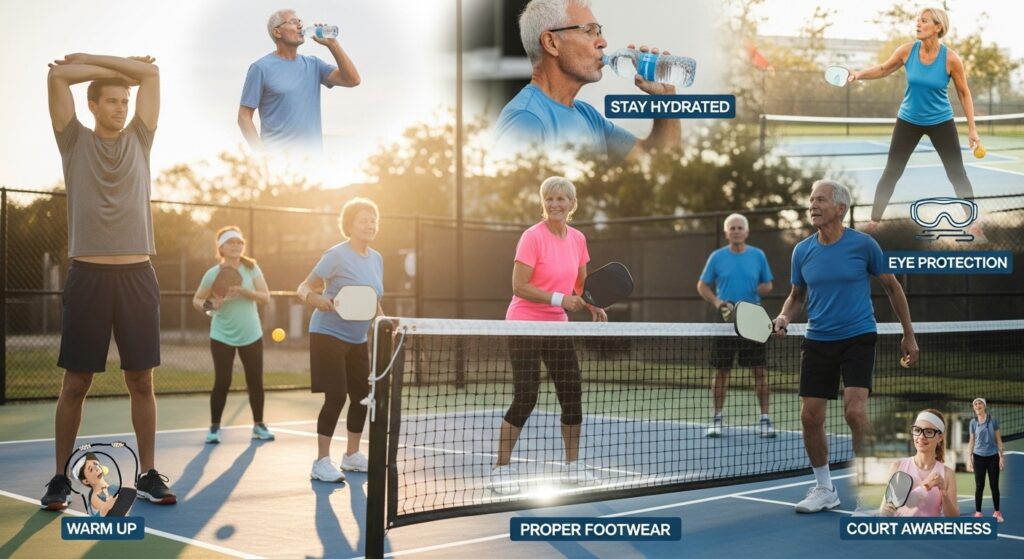
Recommended Routines for Pickleball Players
Integrating specific exercises and routines into your week will not only improve your game but also fortify your body against injury.
Pre-Game Warm-Up Routine (10 minutes)
- Light Cardio (3 mins): Jogging on the spot, high knees, butt kicks.
- Leg Swings (1 min): 10 forward/backward swings and 10 side-to-side swings per leg.
- Torso Twists (1 min): Stand with feet shoulder-width apart and gently twist your upper body from side to side.
- Arm Circles (1 min): 10 large circles forward and 10 backward with each arm.
- Walking Lunges (1 min): Take 10 lunges forward, focusing on good form.
- Light Volleys (3 mins): Start with short, controlled dinks at the net with a partner to activate your hand-eye coordination.
Post-Game Cool-Down and Stretching Routine (10 minutes)
- Light Walk (2-3 mins): Walk slowly around the court to let your heart rate come down.
- Hold each of the following static stretches for 30 seconds per side:
- Hamstring Stretch: Sit on the floor with one leg extended, the other bent. Gently lean forward over the straight leg.
- Quad Stretch: Standing, pull your heel towards your glute. Use a wall for balance.
- Calf Stretch: Stand facing a wall or fence and step one foot back, pressing the heel to the floor.
- Glute/Piriformis Stretch (Figure-Four): Lying on your back, cross one ankle over the opposite knee and gently pull the thigh towards you.
- Shoulder Stretch: Pull one arm across your chest.
- Triceps Stretch: Raise one arm and bend it so your hand is behind your neck. Use the other hand to gently pull the elbow.
- Child’s Pose: A great stretch for the lower back.
Recovery Tips
- Sleep: Aim for 7-9 hours of quality sleep per night. This is when your body does most of its repair work.
- Nutrition: Consume a meal or snack with protein and carbohydrates within an hour of finishing play to help replenish energy stores and repair muscle tissue.
- Active Recovery: On your off days, consider light activities like walking, swimming, or yoga to promote blood flow and reduce muscle soreness without stressing your body.
- Foam Rolling: Using a foam roller on tight muscles like your quads, hamstrings, and calves can help relieve soreness and improve flexibility.
Also Read Pickleball Court Guide: Dimensions, Setup & Cost to Build One?
FAQs: Pickleball and Your Health
Q1: Is pickleball better exercise than tennis?
Neither is definitively “better”; they are different. Tennis is typically a more intense cardiovascular and full-body strength workout. Pickleball is lower-impact, easier on the joints, and more accessible for beginners and seniors. The best exercise is the one you enjoy and will do consistently.
Q2: Can you build muscle playing pickleball?
Pickleball helps build and maintain functional strength and muscle tone, particularly in the legs, core, and shoulders. However, it is not a substitute for resistance training. To build significant muscle mass, you should supplement your pickleball play with a dedicated strength-training program.
Q3: How often should I play pickleball for fitness?
For general health and fitness benefits, aim for at least 150 minutes of moderate-intensity activity per week. This could be achieved with three 50-minute pickleball sessions. For weight loss or more significant cardiovascular improvements, aim for 4-5 sessions per week, incorporating higher intensity play when possible.
Q4: Is pickleball safe for beginners with health conditions?
For many, yes. Its low-impact nature and scalable intensity make it safer than many other sports. However, it is crucial for anyone with a pre-existing health condition (such as heart disease, severe arthritis, or balance issues) to consult with their doctor before starting. Begin slowly, play doubles, and always prioritize safety over competition.
Q5: What is the most common pickleball injury?
Strains and sprains are the most common injuries, particularly to the ankle, knee, and shoulder. Many of these are preventable with proper warm-ups, correct footwear, and good body mechanics. Overuse injuries like “pickleball elbow” (similar to tennis elbow) are also common.
Conclusion: A Sport for Lifelong Fitness
Pickleball is far more than a passing trend. It is a legitimate and highly enjoyable form of exercise that offers a wealth of physical and mental health benefits. From providing an excellent cardio workout and strengthening your muscles to improving balance and fostering social connections, the sport delivers a holistic approach to well-being.
Its low-impact nature and welcoming community make it an ideal fitness solution for people of all ages and abilities, from young adults to seniors. Whether your goal is to lose weight, improve your heart health, or simply find a fun way to stay active, pickleball checks all the boxes.
By following proper safety precautions, listening to your body, and preparing adequately for play, you can enjoy the many benefits of this fantastic sport for years to come. So, grab a paddle, head to a court, and discover for yourself why so many people are falling in love with pickleball as their go-to activity for fun and fitness.
